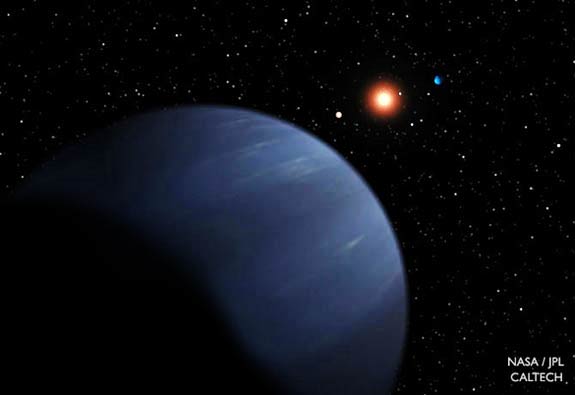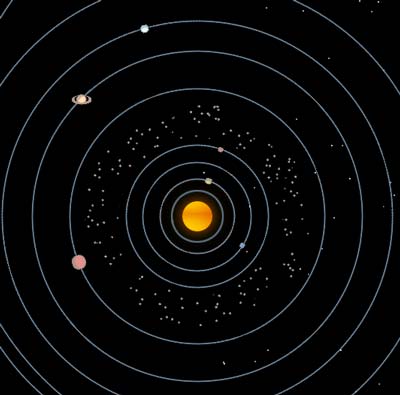Exoplanet in 55 Cancri
Astronomers find a fifth planet in a solar system similar to ours
by Michael D. Lemonick
11/23/07
Learning your planets used to be a lot easier. There were only nine of them, and they all circled our own sun. With Pluto kicked out of the club for failing to make weight, the local census has dwindled even further. But the sun we know is hardly the only one around, and elsewhere in the cosmos, planets are popping up everywhere.
 An artist's rendering of the latest planet discovered orbiting 55 Cancri, which is part of a solar system similar to Earth's.
An artist's rendering of the latest planet discovered orbiting 55 Cancri, which is part of a solar system similar to Earth's.Earlier this month, astronomers from San Francisco State University, the University of California, Berkeley, and the Carnegie Institution of Washington announced the discovery of a fifth planet around the star 55 Cancri, which is 41 light-years away in the constellation Cancer. The find makes that star system the most heavily populated one known other than our sun's and raises to 265 the total of extrasolar planets since astronomers began discovering them in 1995. To skywatchers, however, 55 Cancri is special, not just because of its litter of worlds but because of what it tells us about the possibility of life around it--and other stars.
The newly found planet has about half the mass of Saturn, but its orbit places it about 73 million miles (117 million km) from 55 Cancri, or 20 million miles (32 million km) closer to it than Earth is to the sun. That gives the planet a roughly Earthlike year of 260 days and, more important, puts it in what astronomers call the habitable zone, the distance from its sun at which liquid water can exist. The planet is too dense and gaseous to harbor life as we know it, but if it has any moons, they could be warm enough and wet enough to get biology going.
Like almost all extrasolar planets, the new world is too small and distant to be spotted by telescope. Instead, it was discovered by measuring the tiny wobbles its gravity imposes on the motion of its parent star.
That's a slow process, though. It took 18 years of measurements before the presence of the planet could be confirmed. Now an entirely new planet-hunting strategy, centered on a type of star nobody has been looking at, could reveal in as little as a year a habitable, Earthlike planet--and if the scientists get lucky, more than one.
The key is a type of dim red star known as an M-dwarf, only about a hundredth as bright as the sun. During the 1990s, sky surveys revealed that these puny stars are as thick as ants at a picnic, accounting for up to 70% of all the stars in the Milky Way. Because an M-dwarf is so faint, its habitable zone is much smaller, so any planet that falls within that zone would be much closer to it than Earth is to the sun. And that, says Harvard astronomer David Charbonneau, gives planet hunters a huge advantage. "Basically," he says, "it lets us cheat."
Rather than looking for a stellar wobble, Charbonneau and others are watching red dwarfs for signs of their light subtly dimming as an orbiting planet passes in front of them--a sort of mini-eclipse known as a transit. "If an Earth-size planet in an Earthlike orbit passes in front of a star like the sun," he says, "it dims the star by 1 part in 10,000 or even less." Since a habitable planet around an M-dwarf is much closer--about 7 million miles (11 million km) away--the transit lasts significantly longer. And since the star is smaller and dimmer to begin with, the light reduction from one of these mini-eclipses is more like 1 part in 100.
This telltale flicker is easy to spot even from a small, ground-based telescope. So Charbonneau is setting up an array of eight 16-in. (40 cm) telescopes on Mount Hopkins, near Tucson, Ariz., and pointing them over and over at the 100 closest M-dwarfs to see if their light dims in a repeating pattern. If it does, he won't have long to wait: a habitable M-dwarf planet would have a "year" only three or four days long, so transits would happen all the time. Things will get even easier in 2009, when NASA launches a satellite called Kepler. Soaring above our planet's murky atmosphere, it could spot Earthlike planets transiting across the faces of stars by the dozen.
The silhouette strategy for planet hunting will not replace the wobble-watching method. Indeed, red dwarfs make that method easier and faster. "M-dwarf stars are small," says astronomer Geoff Marcy of UC Berkeley, one of the discoverers of 55 Cancri's newfound planet. "That means planets can kick them around more easily." And all that means the first twin of Earth might really be found before long--and the discovery of life on other worlds could get a whole lot closer.
 See an animation of the movement of planets in our solar system.
See an animation of the movement of planets in our solar system. See amazing views from space
See amazing views from space